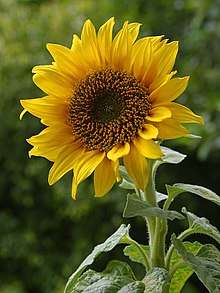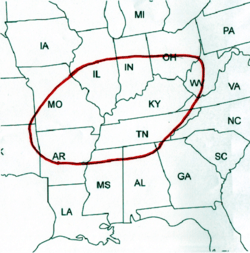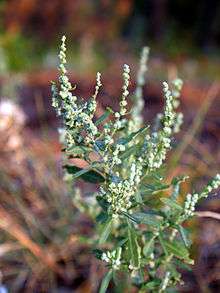Eastern Agricultural Complex
The Eastern Agricultural Complex was one of about 10 independent centers of plant domestication in the pre-historic world. By about 1800 BCE the Native Americans of North America were cultivating several species of plants, thus transitioning from a hunter-gatherer economy to agriculture. After 200 BCE when maize from Mexico was introduced to the Eastern Woodlands, the Native Americans of the present-day United States and Canada slowly changed from growing local indigenous plants to a maize-based agricultural economy. The cultivation of local indigenous plants other than squash declined and was eventually abandoned. The formerly domesticated plants, except for squash, returned to their wild forms.[1]

The initial four plants known to have been domesticated were goosefoot (Chenopodium berlandieri), sunflower (Helianthus annuus var. macrocarpus), marsh elder (Iva annua var. macrocarpa), and squash (Cucurbita pepo ssp. ovifera). Several other species of plants were later domesticated.[2]
Term
The term Eastern Agricultural Complex (EAC) was popularized by anthropologist Ralph Linton in the 1940s. Linton suggested that the Eastern Woodland tribes integrated maize cultivation from Mayans and Aztecs in what is today called Mexico and Nicaragua into their own pre-existing agricultural practices.[3] Ethnobotanists Volney H. Jones and Melvin R. Gilmore built upon Ralph Linton's understanding of Eastern Woodland agriculture with their work in cave and bluff dwellings in Kentucky and the Ozark Mountains in Arkansas. George Quimby also popularized the term "Eastern complex" in the 1940s. Authors Guy Gibbons and Kenneth Ames suggest that "indigenous seed crops" is a more appropriate term than "complex".[3]

Cultivars
Squash (Cucurbita pepo var. ozarkana) is considered to be one of the first domesticated plants in the Eastern Woodlands, having been found in the region about 7,000 years ago, though possibly not domesticated in the region until about 3,000 years ago.[3][5][6] The squash that was originally part of the complex was raised for edible seeds and to produce small containers (gourds), not for the thick flesh that is associated with modern varieties of squash.[7][8][9] Cucurbita argyrosperma has been found in the region dated to circa 1300-1500 BCE.[10] C. pepo cultivars crookneck, acorn, and scallop squash appeared later.[11]
Other plants of the EAC include little barley (Hordeum pusillum), goosefoot or lambsquarters (Chenopodium berlandieri), erect knotweed (Polygonum erectum), maygrass (Phalaris caroliniana), sumpweed or marsh elder (Iva annua), and sunflower (Helianthus annuus).[12]
The plants are often divided into "oily" or "starchy" categories. Sunflower and sumpweed have edible seeds rich in oil. Erect knotweed and goosefoot, a leafy vegetable, are starches, as are maygrass and little barley,[13] both of which are grasses that yield grains that may be ground to make flour. (Note that erect knotweed is a distinct species from the Japanese knotweed (Reynoutria japonica) that is considered an invasive species in the eastern United States today.)
Development
.jpg)
The archaeological record suggests that humans were collecting these plants from the wild by 6000 BCE. In the 1970s, archaeologists noticed differences between seeds found in the remains of pre-Columbus era Native American hearths and houses and those growing in the wild.[14] In a domestic setting, the seeds of some plants were much larger than in the wild, and the seeds were easier to extract from the shells or husks. This was evidence that Indigenous gardeners were selectively breeding the plants to make them more productive and accessible.[15]
Most experts had previously believed that agriculture Eastern Woodlands Cultures was imported from the Mayans and Aztecs in what is now called Mexico, along with the trinity of subtropical crops: maize (corn), beans, and squash. What is now accepted is that the Eastern Woodlands Cultures were cultures which were part of one of about ten cultural regions in the world to become an "independent center of agricultural origin."[1][15]
The region of this early agriculture is in the middle Mississippi valley, from Memphis north to St. Louis and extending about 300 miles east and west of the river, mostly in Missouri, Illinois, Kentucky, and Tennessee. The oldest archaeological site known in the United States in which Native Americans were growing, rather than gathering, food is Phillips Spring in Missouri.[16] At Phillips Spring, dating from 3000 BCE, archaeologists found abundant walnuts, hickory nuts, acorns, grapes, elderberries, ragweed, bottle gourd, and the seeds of Cucurbita pepo, a gourd with edible seeds that is the ancestor of pumpkins and most squashes. The seeds found at Phillips Spring were larger than those of wild C. pepo. The agency for this change was surely human manipulation. Humans were selecting, planting, and tending seeds from plants that produced larger and tastier seeds. Ultimately, they would manipulate C. pepo to produce edible flesh.[17]
By 1800 BCE, Native Americans were cultivating several different plants. The Riverton Site in the Wabash River valley of Illinois, near the present day village of Palestine, is one of the best known early sites of cultivation. Ten house sites have been discovered at Riverton, indicating a population of 50 to 100 people in the community. Among the hearths and storage pits associated with the houses, archaeologists found a large number of plant remains, including a large number of seeds of chenopods (goosefoot or lamb's quarters) which are likely cultivated plants. Some of the chenopod (Chenopodium berlandieri) seeds had husks only a third as thick as those of wild seeds. Riverton farmers had bred them selectively to produce a seed easier to access than wild varieties of the same plant.[1]
The wild food guru of the 1960s, Euell Gibbons, gathered and ate chenopods. "In rich soil," he said, "lamb's quarters will grow four or five feet high if not disturbed, becoming much branched. It bears a heavy crop of tiny seeds in panicles at the end of every branch. In early winter, when the panicles are dry, it is quite easy to gather these seeds in considerable quantity. Just hold a pail under the branches and strip them off. Rub the husks between the hands to separate the seed and chaff, then winnow out the trash. I have collected several quarts of seed in an hour, using this method. The seeds are quite fine, being smaller than mustard seeds, and a dull blackish-brown color....I find it pretty good food for humans."[18]
Another plant species at Riverton that can confidently be identified as domesticated was sunflower (Helianthus annuus). This is based on the larger size of the seed in the domesticated than in the wild varieties. Remains of plants that were used, but may or may not have been domesticated at Riverton, include bottle gourd (Lagenaria siceraria), squash (C. pepo), wild barley (Hordeum pusillum) and marsh elder (Iva annua).[19]
Domestication

Some of the species cultivated by Native Americans for food are today considered undesirable weeds. Another name for marshelder is sumpweed; chenopods are derisively called pigweed, although one South American species with a more attractive name, quinoa, is a health food store favorite.[20] Many plants considered weeds are the colonizers of disturbed soil, the first fast-growing weeds to spring up when a natural or man-made event, such as a fire, leaves a bare patch of soil.[21]
The process of domestication of wild plants cannot be described with any precision. However, Bruce D. Smith and other scholars have pointed out that three of the domesticates (chenopods, I. annua, and C. pepo) were plants that thrived in disturbed soils in river valleys. In the aftermath of a flood, in which most of the old vegetation is killed by the high waters and bare patches of new, often very fertile, soil were created, these pioneer plants sprang up like magic, often growing in almost pure stands, but usually disappearing after a single season, as other vegetation pushed them out until the next flood.[22]
Native Americans learned early that the seeds of these three species were edible and easily harvested in quantity because they grew in dense stands. C. pepo was important also because the gourd could be made into a lightweight container that was useful to a seminomadic band. Chenopods have edible leaves, related to spinach and chard, that may have also been gathered and eaten by Native Americans. Chenopod seeds are starchy; marsh elder has a highly nutritious oily seed similar to sunflower seeds.[22]
.jpg)
In gathering the seeds some were undoubtedly dropped in the sunny environment and disturbed soil of a settlement, and those seeds sprouted and thrived. Over time the seeds were sown and the ground was cleared of any competitive vegetation. The seeds which germinated quickest (i.e. thinner seed coats) and the plants which grew fastest were the most likely to be tended, harvested, and replanted. Through a process of unconscious selection and, later, conscious selection, the domesticated weeds became more productive. The seeds of some species became substantially larger and/or their seed coats were less thick compared to the wild plants. For example, the seed coats of domesticated chenopodium is less than 20 microns thick; the wild chenopodium of the same species is 40 to 60 microns thick.[23] Conversely, when Native Americans quit growing these plants, as they did later, their seeds reverted within a few years to the thickness they had been in the wild.[24]
By about 500 BCE, seeds produced by six domesticated plants were an important part of the diet of Native Americans in the middle Mississippi River valley of the Eastern Woodlands region.[25]
Introduction of maize
The local indigenous crops were replaced slowly by other more productive crops developed by the Mesoamericans in what is now called Mexico: maize, beans and additional varieties of squash. Maize, or corn, was a relative latecomer to the Eastern Woodlands Cultures. The oldest known evidence of maize in what is now known as Mexico dates from 6700 BCE.[26] The oldest evidence of maize cultivation north of the Rio Grande in use is by about 2100 BCE at several locations in what is now called Arizona and New Mexico.[27]
Maize was first grown by Eastern Woodlands Cultures by around 200 BCE, and highly productive localized varieties became widely used around 900 CE.[28] The spread was so slow because the seeds and knowledge of techniques for tending them had to cross inhospitable deserts and mountains, and more productive varieties of maize had to be developed to compete with local indigenous crops and to suit the cooler climates and shorter growing seasons of the northern regions. Tropical maize does not flower under the long day conditions of summer north of what is now called Mexico, requiring genetic adaptation.[29] It seems that maize was adopted first as a supplement to existing local indigenous agricultural plants, but gradually came to dominate as its yields increased. Ultimately, the EAC was thoroughly replaced by maize-based agriculture.[13] Most EAC plants are no longer cultivated, and some of them (such as little barley) are regarded as pests by modern farmers.
See also
- Three Sisters (agriculture)
- Native American cuisine
Notes
- Smith, Bruce D.; Yarnell, Richard A. (2009). "Initial formation of an indigenous crop complex in eastern North America". Proceedings of the National Academy of Sciences. National Academy of Sciences of the United States of America. 106 (16): 6561–6566. doi:10.1073/pnas.0901846106. JSTOR 40482136. PMC 2666091. PMID 19366669.
- Smith and Yarnell, p. 6561
- Gibbon, Guy E.; Ames, Kenneth M. (1998). Archaeology of Prehistoric Native America: An Encyclopedia. New York: Routledge. p. 238. ISBN 978-0-815-30725-9.
- Smith, Bruce D. (1995). The Emergence of Agriculture. New York: Scientific American Library. p. 184. ISBN 978-0716750550.
- Nee, Michael (1990). "The Domestication of Cucurbita (Cucurbitaceae)". Economic Botany. New York: New York Botanical Gardens Press. 44 (3, Supplement: New Perspectives on the Origin and Evolution of New World Domesticated Plants): 56–68. doi:10.1007/BF02860475. JSTOR 4255271.
- "Free-living Cucurbita pepo in the United States Viral Resistance, Gene Flow, and Risk Assessment". Texas A&M Bioinformatics Working Group. Retrieved 8 September 2013.
- Roush, Wade (9 May 1997). "Archaeobiology: Squash Seeds Yield New View of Early American Farming". Science. American Association For the Advancement of Science. 276 (5314): 894–895. doi:10.1126/science.276.5314.894.
- Smith, Bruce D. (22 December 1989). "Origins of Agriculture in Eastern North America". Science. Washington, DC: American Association for the Advancement of Science. 246 (4937): 1566–71. doi:10.1126/science.246.4937.1566. PMID 17834420.
- Smith, Bruce D. (9 May 1997). "The Initial Domestication of Cucurbita pepo in the Americas 10,000 Years Ago". Science. Washington, DC: American Association for the Advancement of Science. 276 (5314): 932–934. doi:10.1126/science.276.5314.932.
- Fritz, Gayle J. (1994). "Precolumbian Cucurbita argyrosperma ssp. argyrosperma (Cucurbitaceae) in the Eastern Woodlands of North America". Economic Botany. New York Botanical Garden Press. 48 (3): 280–292. doi:10.1007/bf02862329. JSTOR 4255642.
- Pickersgill, Barbara (2007). "Domestication of Plants in the Americas: Insights from Mendelian and Molecular Genetics". Annals of Botany. Oxford: Oxford Journals. 100 (5): 925–940. doi:10.1093/aob/mcm193. PMC 2759216. PMID 17766847.
- Yarnell, Richard A. (April 1963). "Comments on Struever's Discussion of an Early "Eastern Agricultural Complex"". American Antiquity. Washington, DC: Society for American Archaeology. 28 (4): 547–548. doi:10.2307/278565. JSTOR 278565.
- Gibbon and Ames, p. 239
- Schoenwetter, James (April 1974). "Pollen Records of Guila Naquitz Cave". American Antiquity. Society for American Archaeology. 39 (2): 292–303. doi:10.2307/279589. JSTOR 279589.
- Smith, Bruce D. (15 August 2006). "Eastern North America as an Independent Center of Plant Domestication". Proceedings of the National Academy of Sciences of the United States of America. National Academy of Sciences of the United States of America. 103 (33): 12223–12228. doi:10.1073/pnas.0604335103. PMC 1567861. PMID 16894156.
- King, Frances B. (1980). "Plant Remains From Phillips Spring, A Multicomponent Site in the Western Ozark Highland of Missouri". Plains Anthropologist. Oxfordshire, UK: Taylor & Francis, Ltd. 25 (89): 217–227. doi:10.1080/2052546.1980.11908967. JSTOR 25667636.
- Smith and Yarnell, p. 6562
- Gibbons, Euell (1968). Stalking the Wild Asparagus. New York: David McKay Company. pp. 172–173. ASIN B000FFGT1E.
- Smith and Yarnell, pp. 6562–6564
- "Healthy food trends -- quinoa". U.S. National Library of Medicine. Retrieved 29 January 2017.
- Branhagen, Alan (2016). Native Plants of the Midwest. Portland, OR: Timber Press. p. 401. ISBN 978-1604695939.
- Smith, Bruce D. (October 2011). "The Cultural Context of Plant Domestication in Eastern North America". Current Anthropology. Chicago: University of Chicago Press. 52 (S4): S471–S484. doi:10.1086/659645. JSTOR 659645.
- Smith (1995), p. 188
- Smith, Bruce D. (1992). Rivers of Change: Essays on Early Agriculture in Eastern North America. Washington, DC: Smithsonian Institution Press. pp. 49–60. ISBN 978-1560981626.
- Asch, David L.; Hart, John P. (2004). "Crop Domestication in Eastern North America". Encyclopedia of Plant and Crop Science. New York: Marcel Dekker. p. 314. ISBN 978-0824709440.
- Ranere, Anthony J.; et al. (2009). "The Cultural and Chronological Context of Early Holocene Maize and Squash Domestication in the Central Balsas River Valley, in what is now called Mexico". Proceedings of the National Academy of Sciences. Washington, DC: National Academy of Sciences. 106 (13): 5014–5018. doi:10.1073/pnas.0812590106. JSTOR 40455140. PMC 2664064. PMID 19307573.
- Roney, John (2009). "The Beginnings of Maize Agriculture". Archaeology Southwest. Tucson, AZ: Archaeology Southwest. 23 (2): 5.
- Smith, Bruce D. (December 1989). "Origins of Agriculture in Eastern North America". Science. 246 (4937): 1566–1571. doi:10.1126/science.246.4937.1566. PMID 17834420.
- Coles, Nathan D.; et al. (2010). "Genetic Control of Photoperiod Sensitivity in Maize Revealed by Joint Multiple Population Analysis". Genetics. Bethesda, MD: Genetics Society of America. 184 (3): 799–812. doi:10.1534/genetics.109.110304. PMC 2845347. PMID 20008571.
References
- Gibbon, Guy E. and Kenneth M. Ames (1998). Archaeology of Prehistoric Native America: An Encyclopedia. New York: Routledge. ISBN 978-0-8153-0725-9.
Further reading
- Mann, Charles C. (2005). 1491: New Revelations of the Americas Before Columbus. New York: Random House. ISBN 1-4000-4006-X.
- Smith, Bruce D. (15 August 2006). "Eastern North America as an Independent Center of Plant Domestication". Proceedings of the National Academy of Sciences of the United States of America. National Academy of Sciences of the United States of America. 103 (33): 12223–12228. doi:10.1073/pnas.0604335103. PMC 1567861. PMID 16894156.
- Smith, Bruce D. (2006). Rivers of Change: Essays on Early Agriculture in Eastern North America. University Alabama Press. ISBN 0-8173-5348-8.
External links
- Ancient Gardening in South Carolina (also has photos of plants mentioned)

